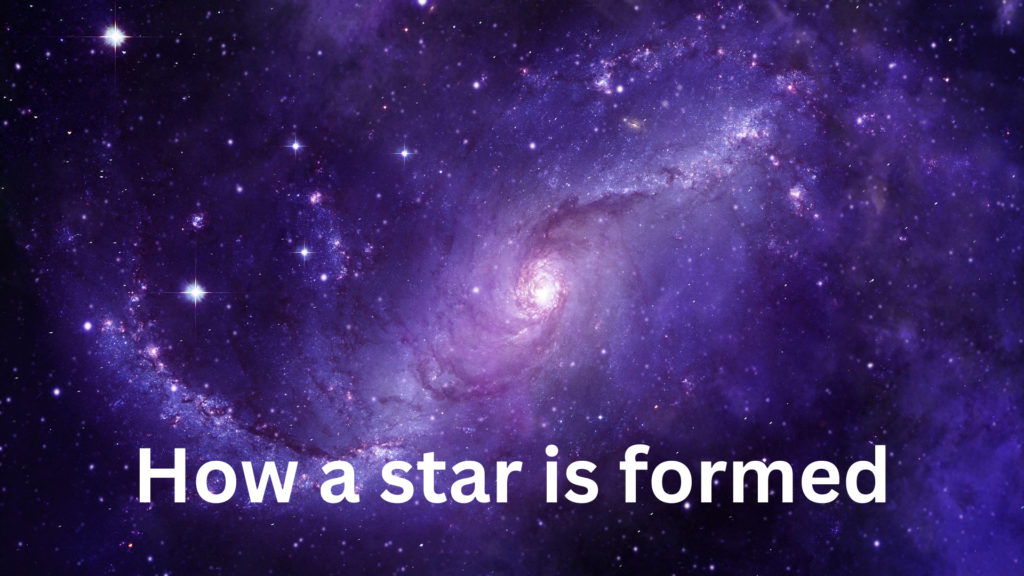

A huge, bright sphere of plasma held together by gravity is called a star. Because they undergo nuclear fusion, stars—the basic building blocks of galaxies—are the universe’s main source of energy. The closest star to Earth is our Sun, which gives life on Earth the heat and light it needs to exist. let’s talk about how a star is formed.
Formation of A Star
Molecular clouds, also referred to as stellar nurseries, are areas of space where stars develop. These clouds are chilly and dense, mainly made of hydrogen gas with traces of heavier elements and helium. There are multiple stages in the star creation process:
1. Gravitational Collapse: A portion of a molecular cloud may collapse due to its inherent gravity in response to an external disruption, such as a shockwave from a nearby supernova. The gas breaks up into smaller clumps as it compresses.
2. Protostar Formation: A cluster warms up and creates a protostar as it collapses further. A revolving disk of gas and dust encircling this young star may someday give rise to planets and other things.
3. Nuclear Fusion Onset: Nuclear fusion occurs when the protostar’s core temperature approaches 10 million Kelvin. A huge quantity of energy is released when hydrogen atoms combine to make helium. The majority of the star’s existence is ahead of it when it reaches the main sequence phase.
Types of Stars
There are different types of stars, categorized by their luminosity and spectral features. The most often used system of categorization is the Morgan-Keenan (MK) system, which groups stars according to their luminosity class (I to V) and spectral type (O, B, A, F, G, K, M):
1. O-Type Stars: These stars are biggest and brightest with surface temperatures that are higher than 30,000 Kelvin. They release extensive amount of UV light and are highly luminous.
2. B-Type Stars: B-type stars have surface temperatures between 10,000 to 30,000 Kelvin, making them marginally colder than O-type stars. They have a blue hue and are also highly bright.
3. A-Type Stars: The surface temperatures of these stars range from 7,500 to 10,000 Kelvin. They include stars like Sirius and are white or bluish white in color.
4. F-Type Stars: The surface temperature of these stars ranges from 7,500 to 10,000 Kelvin. They include stars like Sirius and are white or bluish white in color.
5. G-Type Stars: Our sun is a G-Type star. These stars are yellow in hue and have surface temperatures ranging from 5,200 to 6,000 Kelvin.
6. K-Type Stars: The surface temperatures of these orange stars range from 3,700 to 5,200 Kelvin. They are not as bright as G-type stars and are colder.
7. M-Type Stars: M-type stars are the coolest and most prevalent form of stars; their surface temperatures are less than 3,700 Kelvin. Since they are red, they are frequently called red dwarfs.
Gravity of Stars
Gravity is a force that keeps a star together. Gravity forces all of the mass within a star, increasing the temperature and pressure there. Hydrostatic equilibrium is the balance that results from the outward force created by nuclear fusion in the core opposing this pressure. Stars could not maintain the nuclear fusion reactions that give them their luminosity in the absence of gravity.
Characteristics of Stars
1. Luminosity: The total energy released by a star in a certain amount of time. The temperature and size of the star affect its luminosity.
2. Temperature: A star’s hue varies depending on its surface temperature; it can be blue (hot) or red (cold).
3. Mass: One important aspect of a star’s lifespan is its mass. Less massive stars burn more slowly and have longer lifetimes than more massive stars, which burn hotter and quicker.
4. Size: Less than 0.1 solar radii to more than 100 solar radii can be found in stars. Temperature and brightness are impacted by size.
5. Compositions: With traces of heavier elements, hydrogen and helium make up the majority of a star’s composition. The star’s lifetime and evolution are influenced by its initial makeup.
Lifecycle of Stars
From the moment of formation until their final demise, stars go through multiple stages throughout their lifecycle:
1. Main Sequence: the longest stage, during which the cores of stars combine to form helium from hydrogen. At the moment, the Sun is in this phase.
2. Red Giant/Supergiant: Depending on its starting mass, a star that runs out of hydrogen fuel grows into a red giant or supergiant. Helium fusion is started when the core constricts and becomes heated.
3. Death: A star’s mass determines its fate:
• Low-Mass Stars: White dwarfs are left behind by these stars when they shed their outer layers, forming planetary nebulae, which gradually cool and dissipate.
• High-Mass Stars: When these stars explode as supernovae, neutron stars or black holes are left behind.
Some Popular Stars
1. The Sun :- The Sun, the star at the center of our solar system, is a G-type main-sequence star (G2V), the most famous star in the universe. At 5,500 degrees Celsius (9,932 degrees Fahrenheit) on its surface, it supplies the energy required for life on Earth.
2. Sirius :- Sirius, the brightest star in the night sky, is also referred to as the Dog Star. It is a binary star system made up of the main-sequence star Sirius A and the white dwarf Sirius B. It is situated in the constellation Canis Major.
3. Betelgeuse :- Betelgeuse, a red supergiant star in the constellation Orion, is one of the biggest stars that can be seen with the unaided eye. Its life is coming to a close, and in the next million years, it is predicted to become supernova.
4. Alpha Centauri :- At 4.37 light-years away, this star system is the closest to the Sun. Proxima Centauri, a red dwarf star that is the nearest individual star to our solar system, and Alpha Centauri A and B, which resemble the Sun, make up this triple star system.
5. Vega :- Situated in the constellation Lyra, Vega is among the brightest stars in the night sky. It is a spectral class A0V main-sequence star that is frequently used as a benchmark for astronomical measurements.
Conclusion
Stars are essential to our comprehension of the cosmos. Originating from gas and dust clouds, they have a life span of millions to billions of years before abruptly dying, leaving behind traces that continue to sculpt the universe. Astronomers can discover information about the dynamics of galaxies, the genesis of elements, and the possibility of extrasolar life by observing stars.
